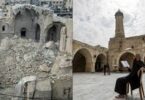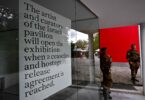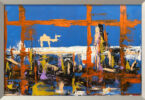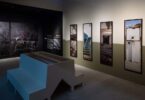Gwen Burlington
BERGEN, Norway —In 1975, when Lene Berg was nine years old, the Norwegian artist’s father, Arnljot Berg, was arrested for the murder of his second wife, the actress Evelyne Zammit. He served a brief prison sentence and, shortly after his return to Norway, took his own life. These events are the nucleus of Lene Berg’s film installation Fra Far (From Father), which gives form to the complex relationship between a father and daughter, a filmmaker and artist, a convicted murderer and his family, a “creative genius” and his legacy, and Norway then and now. These layers slip and slide with fluidity through five different rooms, presenting viewers with different angles on who Arnljot could have been, full of both certainty and doubt. What becomes clear, after the fact, is that nothing seems definite.
The show begins with a seven-minute video, “The Day Rises” (2022), in which a diorama unfolds the subtle details of the event itself, told from Berg’s clouded recollection. The scene fills with vape smoke, model streetlights turn on and off, and the sounds of Arnljot’s snoring, backed by sirens, echo across the space. The artist’s hand changes the model car. Through speculative retelling — misremembering and questioning — Berg conjures a dreamlike scene of the crime, which bears witness to its own creation. Oddly playful in style for the morbid tale, it reveals the fallacious nature of memory. From here, the exhibition intimately charts the fallout since the cataclysmic event for the family Arnljot Berg left behind.
A selection of weavings of Arnjlot’s 35mm celluloid films hang from a high ceiling in “Film Ghosts 1-6” (2022), paying homage to his legacy as a filmmaker. In “Time Machine (Ghosts)” (2022), a sound collage of Norwegian radio broadcasts announce the location of fish, drawing attention to 1970s Norway, before oil and wealth, and when Arnljot was a prominent filmmaker. There is a sense of searching, highlighted by a spotlight that roves around the room. Arnljot Berg is at once hyper-present and absent as the focus of the exhibition. Viewers are denied any sight of Arnljot’s face, with the exception of “Fact and Fiction” (2022), silkscreen prints of grainy French and Norwegian newspaper images from the time of the arrest. Admittedly, the true crime element can offer a sensationalist pleasure, but this is not what carries the work. Berg withholds spectacle and embraces narrative instead.
The question of guilt or innocence surrenders to the emotional weight of the subject, which lingers throughout the exhibition, each room revealing another aspect of upheaval for the artist and her siblings. In the video work “Father’s Days” (2022), we see letters between the imprisoned Arnljot and a young Berg and her family on a TV monitor, read aloud and surrounded by the drawings Berg’s brother (a child at the time) sent to his imprisoned father. At its core the exhibition manifests the anguish of a family whose loved one is convicted of a serious crime. Love and devotion for that person become intertwined with hate, confusion, and disbelief. This is felt most acutely in “The Disappearance” (2022). Speaking through an analogue phone, Berg addresses her father. Describing times when he would go missing for days, she says, “Sometimes I miss you so much I can’t breathe,” followed by, “If you hadn’t done it yourself, I would have killed you with my own hands.”
In addition to offering a rich meditation on the subjectiveness of memory and truth, Fra Far is, ultimately, a tender posthumous portrait of Berg’s father on her own terms, full of real and speculative recollections. The artist subverts the unidirectional gaze that often haunts criminalized subjects. Instead she offers a metanarrative whose heartbreak and complexity linger long after.
Courtesy: hyperallergic






